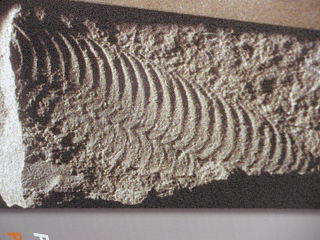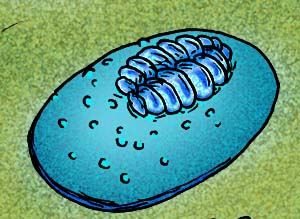
The Ediacaran Period is a geological period that spans 94 million years from the end of the Cryogenian Period 635 million years ago (Mya), to the beginning of the Cambrian Period 541 Mya. It marks the end of the Proterozoic Eon, and the beginning of the Phanerozoic Eon. It is named after the Ediacara Hills of South Australia.

Pteridinium is an erniettomorph found in a number of Precambrian deposits worldwide. It is a member of the Ediacaran biota.

Dickinsonia is an extinct genus of basal animal that lived during the late Ediacaran period in what is now Australia, China, India, Russia and Ukraine. The individual Dickinsonia typically resembles a bilaterally symmetrical ribbed oval. Its affinities are presently unknown; its mode of growth is consistent with a stem-group bilaterian affinity, though some have suggested that it belongs to the fungi, or even an "extinct kingdom". The discovery of cholesterol molecules in fossils of Dickinsonia lends support to the idea that Dickinsonia was an animal.

Kimberella is an extinct genus of bilaterian known only from rocks of the Ediacaran period. The slug-like organism fed by scratching the microbial surface on which it dwelt in a manner similar to the gastropods, although its affinity with this group is contentious.

The Bhimbetka rock shelters are an archaeological site in central India that spans the Paleolithic and Mesolithic periods, as well as the historic period. It exhibits the earliest traces of human life in India and evidence of Stone Age starting at the site in Acheulian times. It is located in the Raisen District in the Indian state of Madhya Pradesh about 45 kilometres (28 mi) south-east of Bhopal. It is a UNESCO World Heritage Site that consists of seven hills and over 750 rock shelters distributed over 10 km (6.2 mi). At least some of the shelters were inhabited more than 15,000 years ago. The rock shelters and caves provide evidence of, according to Encyclopædia Britannica, a "rare glimpse" into human settlement and cultural evolution from hunter-gatherers, to agriculture, and expressions of prehistoric spirituality.

Yorgia waggoneri is a discoid Ediacaran organism. It has a low, segmented body consisting of a short wide "head", no appendages, and a long body region, reaching a maximum length of 25 cm (9.8 in). It is classified within the extinct animal phylum Proarticulata.

Cephalonega stepanovi is a fossil organism from Ediacaran deposits of the Arkhangelsk Region, Russia. It was described by Mikhail A. Fedonkin in 1976
Chondroplon bilobatum is a medusoid Ediacaran fossil. It has sand-filled tubes, although these may not have been sand-filled in life. It has a shield-like shape, with one end different from the other, and bilateral symmetry claims that it possesses glide reflection symmetry are based upon a taphonomic effect deforming some specimens. Chondroplon was originally described by Mary Wade in 1971 from fossils found in South Australia. It was named after chondrophores — chitinous floats found on some kinds of colonial floating hydroids.

Swartpuntia is a monospecific genus of erniettomorph from the terminal Ediacaran period, with at least three quilted, leaf-shaped petaloids — probably five or six. The petaloids comprise vertical sheets of tubes filled with sand. Swartpuntia specimens range in length from 12 to 19 cm, and in width from 11.5 to 140 cm. The margin is serrated, with a 1 mm wide groove. A 14 mm wide stem extends down the middle, tapering towards the top, and stopping 25 mm from the tip. The stem has a V shaped ornamentation on it. The original fossils were found at, and named after, the Swartpunt farm between Aus and Rosh Pinah in Namibia. The generic name comes from Swartpunt, meaning black point in reference to the colour of the rocks. The specific name germsi honours Gerard Germs, who studied the Nama formation of geological beds.

Proarticulata is a proposed phylum of extinct, bilaterally symmetrical animals known from fossils found in the Ediacaran (Vendian) marine deposits, and dates to approximately 567 to 550 million years ago. The name comes from the Greek προ = "before" and Articulata, i.e. prior to animals with true segmentation such as annelids and arthropods. This phylum was established by Mikhail A. Fedonkin in 1985 for such animals as Dickinsonia, Vendia, Cephalonega, Praecambridium and currently many other Proarticulata are described.

Marine invertebrates are the invertebrates that live in marine habitats. Invertebrate is a blanket term that includes all animals apart from the vertebrate members of the chordate phylum. Invertebrates lack a vertebral column, and some have evolved a shell or a hard exoskeleton. As on land and in the air, marine invertebrates have a large variety of body plans, and have been categorised into over 30 phyla. They make up most of the macroscopic life in the oceans.

Vendiamorpha is a class of extinct animals within the Ediacaran phylum Proarticulata.

Eoandromeda is an Ediacaran organism consisting of eight radial spiral arms, and known from two taphonomic modes: the standard Ediacara type preservation in Australia, and as carbonaceous compressions from the Doushantuo formation of China, where it is abundant.

Isomer is an element of transverse body articulation of the bilateral fossil animals of the Phylum Proarticulata from the Ediacaran (Vendian) period. This term has been proposed by Andrey Yu. Ivantsov, a Russian paleontologist from the Laboratory of the Precambrian organisms, Paleontological Institute, Russian Academy of Sciences.

The Erniettomorphs are a form of Ediacaran fossil consisting of rows of airbed-like tubes arranged along a midline with a glide symmetry. Representative genera include Ernietta, Phyllozoon, Pteridinium, Swartpuntia and possibly Dickinsonia. Undisputed Erniettomorphs were Ediacaran, but the species Erytholus, Rutgersella, and Protonympha, who have by some been included in this group but are by no means clear members, are found through to the Late Devonian. Their affinity is uncertain; they probably form a clade and are most likely a sister group to the rangeomorphs, which bear a similar construction. Placements within the metazoan crown-group have been rebutted, and it is most likely that these peculiar organisms lie in the stem group to the animals. There is no evidence that they possessed a mouth or gut. Because they may have been found in water which was too deep to permit photosynthesis - and in some cases, lived half-buried in sediment, it is speculated that they fed by osmosis from the sea water. Such a lifestyle requires a very high surface area to volume ratio - higher than is observed in fossils. However, this paradox can be resolved if much of the volume of the organisms was not metabolically active. Many Pteridinium fossils are found completely filled with sand; if this sand were present within the organism while it was alive, this would reduce its metabolically active volume enough to make osmotic feeding viable.

Epibaion is a trace fossil imprint of the Ediacaran animals of the phylum Proarticulata, which became extinct in the Precambrian. Imprints often occurring in chains, that is interpreted as a feeding trace; some chains terminate in a body fossil, allowing their maker to be identified. Several specimens are known; E. waggoneris was produced by Yorgia waggoneri; E. costatus by Dickinsonia costata, and E. axiferus, the type species, has as yet not been found with a trace-maker. It is proposed that the Australian fossil Phyllozoon is also a feeding trace of Proarticulata.

Andiva ivantsovi is a Vendian fossil, identified to be a bilaterian triploblastic animal in the Ediacaran phylum Proarticulata, known from the Winter Coast, White Sea, Russia. It was first discovered in 1977, and described as a new species in a new genus by Mikhail Fedonkin in 2002. It lived about 555 million years ago. Fossils of Andiva also occur in South Australia. All known fossils of Andiva are external molds.

Rutgersella truexi is a form species for problematic fossils of Early Silurian age in Pennsylvania. It has been of special interest because of its morphological similarity with the iconic Ediacaran fossil Dickinsonia, and may have been a late surviving vendobiont.
Palaeoplatoda is a genus from the Ediacaran biota. It is a soft-bodied organism with a segmented body that resembles Dickinsonia, another Ediacaran organism.

Cyanorus singularis is a small proarticulatan, closely related to Spriggina and Marywadea. Its two largest pairs of appendages are located on the anterior part of the body. The anterior part of the body was most likely not segmented. The axial structure of it combines features of the Vendia species and Dickinsonia species. It was found in the Upper Vendian of the White Sea area, Arkhangel'sk Region. It is a White Sea Ediacaran fossil and it became extinct during the Late Precambrian.
















